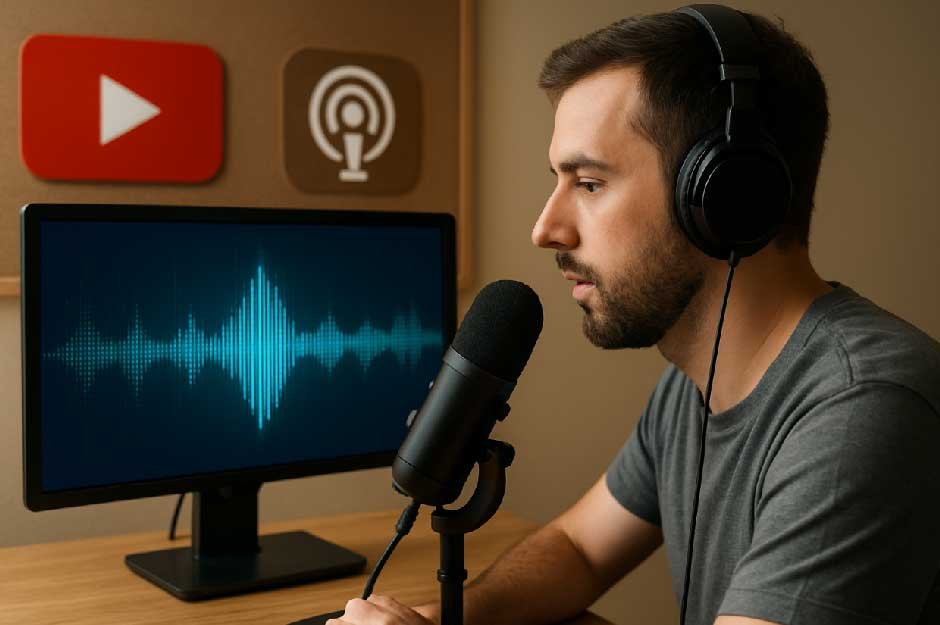Skip to the good bit
ToggleVoice technology has come a long way, especially with the help of artificial intelligence. Today, as a content creator, you no longer need to spend hours recording, editing, and re-recording your voiceovers. Instead, you can create a digital replica of your voice, also known as a voice clone, that uses voice data to create realistic consistent, and ready for use voice content across your podcast or YouTube channel.Whether you want to streamline content production, improve accessibility, or experiment with AI dubbing for multilingual versions, voice cloning can be a practical tool for your content strategy.
Why Clone Your Voice?
If you’re building a brand on YouTube or running a regular podcast, you understand how important your voice is. It’s your identity, your tone, and your connection with your audience. But recording every script manually can become exhausting and time-consuming. Voice cloning offers a way to maintain consistency and scale up your production without compromising on audio quality.
You might also want to use voice clones for repurposing content on other platforms, automating voiceovers for shorts or reels, or adapting your message to different formats like audiobooks or explainers.
How Does Voice Cloning Work?
The process starts by training an AI model on your voice. You record a raw voice sample, typically 10 to 30 minutes of clean audio that reflects your natural tone and speaking style. The AI uses this data to create a voice profile. Once your digital voice is generated, you can input scripts or text, and the system will synthesize spoken audio that sounds just like you.
Most AI tools offer control over pacing, emotion, pitch, and even emphasis, making it easy to sound natural in various contexts, from storytelling to marketing.
Getting Started with Voice Cloning
To make a high-quality voice clone for your podcast or YouTube channel, follow these practical steps:
- Choose the Right Tool
Select an AI platform that specializes in voice cloning. Look for features like high-fidelity output, support for long-form content, customization options, and compatibility with your existing content formats. Some platforms even offer built-in AI noise cancellation, which is helpful if your raw audio has minor background sounds.
- Record a High-Quality Sample
Use a professional microphone and record in a quiet room. Your audio should be free from background noise, reverb, or interruptions. Clear articulation and consistency in tone make it easier for the AI to model your voice accurately.
- Train and Test Your Voice Clone
Upload your voice sample to the tool. After processing, you’ll receive an AI-generated clone. Try it out by typing a few sample sentences and adjusting tone or pacing. The more you test, the better you’ll understand its strengths and limitations.
- Integrate the Clone Into Your Workflow
Once you’re satisfied with the results, use your clone in your podcast episodes, explainer videos, voiceovers, or even for social media teasers. You can easily generate audio in your cloned voice with just a script, saving hours of production time.
AI Voice Cloning in Real-World Content Creation
Incorporating AI voice cloning into your workflow helps you scale your audio content while maintaining a personal touch. Platforms like invideo AI not only support voice synthesis but also help you match your voiceovers to video timelines. This makes it ideal for content creators who work across multiple platforms.
Let’s say you’re producing weekly podcast episodes and simultaneously managing a YouTube channel. Instead of recording two separate voiceovers, you can use the same script with your AI voice clone and synchronize it for both formats. Add a few platform-specific visuals using an AI video app, and your content is ready for distribution.
AI voice cloning also supports commercial use cases like internal training videos, marketing presentations, or explainer content. For example, in a corporate setting, your digital voice can guide employees through onboarding modules or narrate presentation decks, saving time while maintaining consistency in tone.
Moreover, combining AI voice tech with AI noise cancellation ensures your final output sounds studio-grade, even if your original sample wasn’t perfect.
Tips for Better Voice Cloning Results
- Speak naturally during sample recording: Avoid exaggerated enunciation or artificial tone.
- Stick to your content tone: If your content is casual, don’t force a formal script when training the voice.
- Use voice cloning ethically: Always disclose when a voice is generated, and don’t imitate others without consent.
- Leverage AI dubbing: Clone your voice and translate content into multiple languages while preserving vocal identity.
Optimizing for Podcast Marketing and Social Reach
When you’re using voice clones, don’t forget to optimize your outreach. Podcast marketing becomes more manageable when you can generate bite-sized audio clips for social media. Voice clones help you create teaser trailers, recap clips, and calls-to-action quickly. You can pair them with captions and visuals using smart editing tools to drive engagement.
Similarly, YouTube creators can benefit from a consistent tone across their content library, even for older videos. If you’ve updated your branding or voice style, an AI voice clone allows you to remaster existing scripts without starting from scratch.
Conclusion
Learning how to use AI voice cloning can make a real difference in how efficiently you create, scale, and manage your content, whether it’s for a podcast, YouTube channel, or commercial project. By integrating platforms like invideo AI into your workflow, you open new possibilities for personalization, consistency, and creative freedom. As long as you follow ethical guidelines and stay aligned with your brand voice, voice cloning is a smart way to evolve your content strategy in today’s AI-driven landscape.







